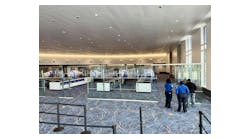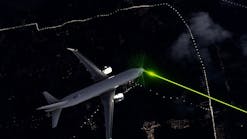Following on from passport and fingerprint scans, facial recognition technology has emerged as a critical tool in enhancing airport security and streamlining passenger processes in the United States and worldwide. In fact, by 2025 it’s expected that over half (53%) of airports around the world will use biometrics as security checkpoints.
With advancements in biometric technology and the advent of initiatives like the International Air Transport Association's (IATA) One ID program, airports and airlines are increasingly integrating facial recognition into various touchpoints of the passenger journey.
In this piece, we’ll explore the different aspects of facial recognition adoption in US airports, including why it is expanding so rapidly now and what the ethical and regulatory considerations are.
Driving Forces Behind Adoption
Firstly, reliable identity verification is absolutely critical for ensuring airport and airline security. Biometric solutions, particularly facial recognition technology, offer a degree of certainty that traditional methods often cannot match. If biometric passports are used on a widespread basis, this will lay the platform for adopting facial recognition technology, facilitating seamless integration into the existing infrastructure.
Additionally, initiatives like the Transportation Security Administration's (TSA's) PreCheck program and airline-specific digital ID systems highlight industry stakeholders' commitment to leveraging biometrics for improved efficiency and convenience. The idea is that using faces instead of traditional documents will reduce wait times and improve the overall travel experience.
Implementation and Expansion
The TSA has been at the forefront of facial recognition technology since 2019. According to the US Border and Customs Protection website, there are already “238 airports using Biometric Facial Comparison Technology in the air entry environment, including all 14 CBP Preclearance locations, and 49 locations for air exit.” Airlines like Delta, American, and United have also embarked on initiatives to integrate facial recognition into various stages of the passenger journey, from check-in to boarding.
For example, Delta's Digital ID and American Airlines' PreCheck screening enable travelers to expedite processes like bag drop and security screening by using their faces for identity verification. Additionally, airports like Miami International Airport have already made big investments in biometric technology across a portion of their departure gates to enhance efficiency and passenger facilitation.
Operational Efficiency
Implementing initiatives like IATA's One ID program aims to create a seamless and contactless passenger journey through advanced information sharing and digital identity technology. Obtaining the necessary authorizations in advance and utilizing live biometric images means that passengers can navigate airport touchpoints swiftly, which, in turn, reduces processing times and terminal congestion.
A study from the International Journal of Information Management Data Insights analyzing the use of biometric technology at airports found that the percentage of passengers processed within 30 minutes increased from 65% to 87% when biometrics were introduced in Dublin airport.
Furthermore, the integration of facial recognition into various airport processes, such as check-in, security screening, and boarding, has been met with positive feedback from passengers and industry stakeholders. According to a recent survey, 73% of passengers state that they are happy to share their biometric data to improve airport processes.
International Perspectives
While the adoption of facial recognition technology in US airports is making strides, international counterparts have also kept up the pace in this regard. Airports like Singapore's Changi Airport and Frankfurt Airport in Germany have implemented passport-free departures and comprehensive biometric solutions throughout the passenger journey.
In particular, Singapore's initiative to introduce automated, passport-free immigration clearance is a strategic measure aimed at future-proofing the bustling airport and effectively managing the anticipated surge in traveler volume. Similarly, China boasts a high adoption rate of biometric technology in its airports, indicating a global trend toward leveraging facial recognition for enhanced security and operational efficiency.
These international developments highlight the competitive landscape within the aviation industry, with airports and airlines worldwide all jostling with each other to offer cutting-edge technologies and seamless travel experiences. As such, there is mounting pressure to innovate and invest in biometric solutions, not solely driven by domestic factors, but also by the need to remain competitive on a global scale
Regulatory and Ethical Consideration
While this rapid expansion of facial recognition technology in airports is showing no signs of slowing down, regulatory and ethical considerations must be considered in determining how it will be utilized safely. Governmental agencies like the TSA and Customs and Border Protection have to strike the balance between implementing robust security initiatives with individual privacy rights.
Towards the end of last year, Senators Jeff Merkley and John Kennedy introduced the Traveler Privacy Protection Act, aiming to stop the TSA.'s facial recognition program over security concerns and potential racial discrimination. This just goes to show that there are ongoing debates surrounding the appropriate use of facial recognition technology and the need for robust safeguards to protect passenger privacy.
Furthermore, we collectively need to address concerns about potential biases and errors in facial recognition algorithms to ensure fair and unbiased implementation without prejudice or unintended negative consequences. Everyone concerned in policy-making in the field must engage in ongoing dialogue and collaboration to develop standards and best practices prioritizing accuracy, fairness, and transparency in biometric identification processes.
There can be no doubt that the adoption of facial recognition technology in US airports represents a dramatic shift towards enhanced security, operational efficiency, and passenger convenience. However, at the same time, navigating the complexities of regulatory compliance, ethical considerations, and technological advancements requires collaboration and proactive engagement from everyone involved.
Firstly, airports need to realize that it is crucial to establish a reliable network connection to meet operational requirements, ensuring the timely processing of passengers, on-time departure performance of aircraft, and mitigating inefficiencies caused by system disruptions.
As individuals become increasingly informed about the advantages of biometrics, they will be more willing to collaborate. It must be made clear that biometric systems uphold privacy standards. For instance, images are not transmitted in their original form; rather, they are encoded as templates, comprising encrypted binary data that cannot be reconstructed into images.
By addressing these challenges and leveraging international best practices, the aviation industry in the US can harness the full potential of Biometrics technology while upholding the key principles of privacy, fairness, and accountability.



